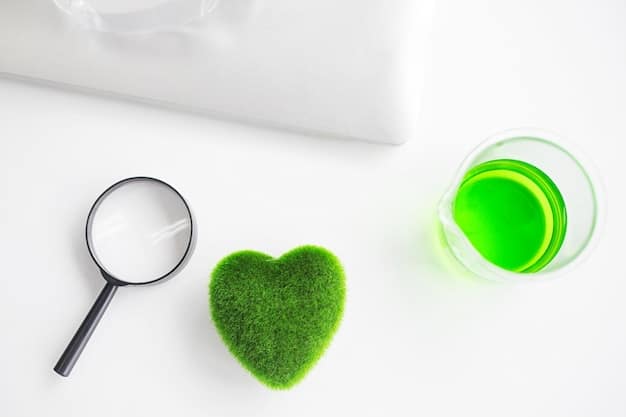Greenwashing: Identify Misleading Eco-Friendly Claims 2025

Navigating the increasingly complex landscape of environmentally conscious consumerism requires understanding greenwashing, the deceptive marketing practice that falsely portrays products or companies as eco-friendly, demanding vigilance to identify and avoid misleading claims by 2025.
In an era where environmental consciousness is growing, consumers are increasingly seeking out products and brands that align with their values. However, this rising demand for sustainability has unfortunately paved the way for a pervasive and insidious practice known as greenwashing: how to identify and avoid misleading eco-friendly claims in 2025. It’s a deceptive tactic that can undermine genuine efforts towards a greener future, leaving consumers confused and disillusioned.
The deceptive allure of greenwashing
Greenwashing is not a new phenomenon, but its sophistication and prevalence are escalating in tandem with consumer environmental awareness. It refers to the practice where a company or organization spends more time and money marketing itself as environmentally friendly than actually minimizing its environmental impact. Imagine a product adorned with lush green labels and vague “natural” claims, while its production process is anything but sustainable. This is greenwashing at its core.
The intent behind greenwashing is often clear: to capitalize on the growing market of eco-conscious consumers. By appearing environmentally responsible, companies aim to enhance their brand image, attract new customers, and sometimes even deflect criticism about their actual environmental footprint. In 2025, with climate change concerns at an all-time high, the pressure on businesses to demonstrate their eco-credentials is immense, making the temptation for greenwashing even stronger.
Understanding the subtle tactics
Greenwashing rarely involves outright lies. Instead, it thrives on ambiguity, selective disclosure, and visual cues designed to mislead. Companies might use imagery like trees, leaves, or earth tones, or terms like “eco-friendly,” “natural,” or “sustainable” without providing concrete evidence or certified claims. It’s about creating a perception rather than demonstrating actual performance.
One common tactic is the “hidden trade-off.” This occurs when a company highlights a minor eco-friendly attribute while ignoring significant environmental harm elsewhere in the product’s life cycle. For example, paper that is “sustainably harvested” might still require extensive energy and water to produce, or generate significant pollution during processing.
Another tactic is “no proof.” Companies make environmental claims but offer no supporting information or third-party certifications. They merely state that a product is “biodegradable” without providing data on how or where it degrades, or within what timeframe.
- Vague language: Using terms like “green,” “eco,” or “natural” without specific, verifiable details.
- Irrelevant claims: Highlighting a genuine but insignificant eco-friendly attribute that distracts from larger issues.
- Fibbing: Making outright false claims, which, while less common due to legal risks, still occur.
The deceptive nature of greenwashing lies in its ability to manipulate perception. It leverages consumers’ desire to “do good” and makes it difficult to distinguish between truly sustainable practices and superficial marketing ploys. As we move further into 2025, the sophistication of these tactics is expected to evolve, demanding a more critical and informed approach from consumers.
Recognizing common greenwashing claims in 2025
As consumers, our first line of defense against greenwashing is to be able to recognize its manifestations. Companies employ various strategies to appear green, and understanding these can significantly enhance our ability to make truly informed choices. In 2025, these tactics will likely become even more nuanced, blending seamlessly into sophisticated marketing campaigns.
One of the most frequent claims is the “natural” fallacy. While “natural” sounds appealing, it doesn’t automatically mean sustainable or safe. Arsenic is natural, but highly toxic. Many natural ingredients require intensive farming practices, extensive land use, or harmful pesticides. A product labeled “all natural” might still contain ingredients that deplete natural resources or harm biodiversity during their extraction.
The “eco-friendly” and “sustainable” dilemma
Terms like “eco-friendly” and “sustainable” are inherently vague and often used without clear definitions. What exactly makes a product eco-friendly? Is it carbon neutrality, recyclable packaging, or reduced water usage? Without specific metrics or certifications, these terms are often hollow.
Similarly, “sustainable” implies a practice that can be maintained indefinitely without depleting natural resources. But few products or processes are entirely sustainable from cradle to grave. Companies might highlight one sustainable aspect, such as using recycled plastic in packaging, while the product itself is energy-intensive to manufacture or transported globally, negating the sustainable packaging benefit.

Consider claims about “carbon neutrality” or “net-zero.” While commendable goals, many companies achieve these through carbon offsetting, which involves funding projects elsewhere to compensate for their own emissions. While offsets can play a role, critics argue that they can also allow companies to continue polluting without fundamentally changing their operations. It’s crucial to look beyond the claim and understand the underlying actions.
- Circular economy buzzwords: Terms like “upcycled,” “closed-loop,” and “cradle-to-cradle” are gaining traction. While these concepts are genuinely sustainable, companies might use them superficially without fully committing to the systemic changes required.
- Green certifications: Identifying genuine, third-party certifications (e.g., Fair Trade, Organic, Energy Star) versus self-declared “green” labels. Verifying the credibility of these certifications is key.
- “Biodegradable” and “compostable” claims: These terms often come with caveats. Biodegradable in what conditions? How long does it take? Compostable in a commercial facility or a backyard compost pile? These details are critical but often omitted.
The increasing complexity of supply chains and manufacturing processes makes it challenging to verify every claim. However, by asking critical questions and looking for specific, verifiable data, consumers can empower themselves to cut through the greenwash and support genuinely sustainable initiatives. In the realm of eco-friendly choices, skepticism is a powerful tool.
Verifying claims: Tools and resources for consumers in 2025
Being aware of greenwashing tactics is only the first step; the next is equipping ourselves with the knowledge and tools to verify environmental claims. In 2025, a growing ecosystem of resources and technologies is designed to help consumers make more informed decisions, but vigilance remains paramount.
One of the most effective ways to verify claims is to look for credible, third-party certifications. These certifications are issued by independent organizations that have established rigorous standards and auditing processes. They lend legitimacy to environmental claims because they are not self-proclaimed.
Navigating certifications and labels
Many legitimate certifications exist across various industries. For instance, in textiles, labels like GOTS (Global Organic Textile Standard) or Oeko-Tex certify products that meet strict environmental and social criteria. For wood products, FSC (Forest Stewardship Council) ensures responsible forest management. Understanding what these certifications represent is crucial.
However, it’s also important to be aware of “fake” or company-created certifications. Some companies invent their own seals or labels that look official but lack independent verification or transparent standards. Always check the certification body’s website, its criteria, and its reputation. A quick online search can often reveal whether a certification is genuine or merely a marketing ploy.
Beyond certifications, technology offers new avenues for verification. QR codes on packaging might lead to detailed product life cycle assessments or sustainability reports. Blockchain technology is emerging as a tool to ensure supply chain transparency, allowing consumers to trace a product’s journey from raw material to finished good, verifying claims about ethical sourcing or environmental impact.
- Independent consumer watchdog groups: Organizations like the Environmental Working Group (EWG) or the European Environmental Bureau (EEB) often publish reports and guides on greenwashing and provide insights into company practices.
- Government regulations and guidelines: Familiarize yourself with regulations like the North American Consumer Protection Act or the EU Unfair Commercial Practices Directive. While enforcement can vary, these aim to prevent misleading environmental claims.
- Product review websites and forums: While not always definitive, collective consumer experiences and reviews can sometimes highlight discrepancies between a company’s claims and its actual performance. Look for consistent feedback, not isolated complaints.
In 2025, the proliferation of data and digital tools means that consumers have unprecedented access to information. However, this also means knowing how to sift through the noise and identify reliable sources. Developing a critical eye and a habit of double-checking claims will be invaluable in combating greenwashing effectively.
The impact of greenwashing on consumers and the environment
Greenwashing is more than just misleading advertising; it has far-reaching consequences that negatively impact consumers, the environment, and the credibility of genuine sustainability efforts. Understanding these repercussions can underscore the importance of combating this deceptive practice.
For consumers, greenwashing leads to confusion and distrust. When individuals try to make environmentally responsible choices but are repeatedly deceived, they can become cynical about all green claims, even legitimate ones. This “green fatigue” can disincentivize genuine eco-friendly consumerism, undermining the collective effort to shift towards a more sustainable economy.
Eroding consumer trust and effective action
The erosion of trust is perhaps one of the most damaging long-term effects. If consumers cannot distinguish between truly sustainable brands and those merely paying lip service, they may simply give up trying. This cynicism benefits neither conscientious businesses nor the planet. It makes it harder for innovative, genuinely sustainable products to gain market share, as they are unfairly lumped in with the greenwashers.
From an environmental perspective, greenwashing can actively harm the planet. By directing consumer demand towards falsely green products, it diverts resources and attention away from addressing real environmental problems. For example, if consumers purchase products that claim to be “carbon neutral” but rely on ineffective offsets, the underlying emissions problem persists, or even worsens, while the company profits from its “green” image.

Moreover, greenwashing can create a false sense of progress. If companies are perceived as sustainable when they are not, there is less pressure for them to adopt truly impactful environmental practices. This stymies innovation in genuine sustainability, as the market reward for real change is diluted by those who merely appear green.
- Misallocation of resources: Consumer spending misled by greenwashing supports businesses that aren’t truly sustainable, meaning financial resources aren’t channeled to where they could make a real environmental difference.
- Unfair competition: Ethical businesses that invest heavily in genuine sustainability are at a disadvantage compared to greenwashing competitors who cut corners by merely marketing themselves as green.
- Delayed climate action: By permitting the illusion of environmental progress, greenwashing can reduce the urgency among both consumers and policymakers to implement more stringent regulations and impactful environmental policies.
Ultimately, greenwashing is a barrier to a truly sustainable future. It makes it harder for consumers to vote with their wallets, undermines the integrity of environmental claims, and delays the necessary systemic changes required to address pressing ecological challenges. Recognizing its impact is crucial for fostering a more discerning market and driving meaningful environmental change.
Empowering consumers: Responsible consumption in 2025
Moving beyond simply identifying greenwashing, consumers in 2025 have a significant role to play in actively promoting genuine sustainability through responsible consumption. This involves a proactive approach, combining skepticism with support for authentic eco-friendly practices.
The first step in empowering ourselves is to adopt a mindset of critical inquiry. Don’t take claims at face value. Ask questions. “What does ‘eco-friendly’ actually mean for this product?” “Where are the details supporting this ‘sustainable’ claim?” A healthy dose of skepticism can protect against deceptive marketing.
Beyond basic verification: Holistic assessment
Responsible consumption goes beyond checking individual product labels. It involves looking at the brand’s overall commitment to sustainability. Do they have transparent supply chains? Are they investing in renewable energy? Do they have a track record of environmental advocacy or community engagement? A holistic assessment of a company’s practices provides a more accurate picture than isolated claims.
Supporting certified ethical and environmental brands is crucial. When we choose companies that have undergone rigorous third-party auditing for their environmental and social performance, we send a clear market signal that genuine sustainability is valued. This encourages more businesses to invest in verifiable eco-credentials rather than superficial green marketing.
Engaging with companies is also important. If you encounter a claim you doubt, reach out to the company and ask for clarification or evidence. Your questions, especially when multiplied by many consumers, can pressure companies to be more transparent and accountable. Similarly, praising companies that genuinely excel in sustainability reinforces positive behavior.
- Research product life cycles: Understand the environmental impact of a product from its raw materials to disposal. This broader perspective helps identify hidden issues greenwashers exploit.
- Support local and circular economies: Prioritizing local products reduces transportation emissions, while supporting businesses that repair, reuse, and recycle helps create a more sustainable system.
- Advocate for stronger regulations: Engage with policymakers and support initiatives that push for clearer, stricter regulations on environmental marketing claims, making it harder for greenwashers to operate.
In 2025, responsible consumption is not just about avoiding bad actors; it’s about actively championing good ones. By making conscious purchasing decisions, demanding transparency, and advocating for systemic change, consumers can collectively push industries towards a genuinely greener future, making greenwashing an increasingly unprofitable and unsustainable practice.
The future of green marketing and regulation in 2025
As we look towards the immediate future, particularly in 2025, the landscape of green marketing is poised for significant shifts. The growing public awareness of environmental issues, coupled with the increasing sophistication of greenwashing tactics, is compelling both regulatory bodies and industry players to adapt.
One major trend anticipated in 2025 is the strengthening of regulatory frameworks around environmental claims. Governments globally are recognizing the need for clearer guidelines and stricter enforcement to curb misleading marketing. This could involve more prescriptive rules about what constitutes an “eco-friendly” claim, mandatory disclosure of environmental impact data, and heavier penalties for non-compliance.
Evolving industry standards and transparency
Industry self-regulation is also expected to evolve. As more businesses commit to genuine sustainability, there’s a growing incentive for them to differentiate themselves from greenwashers. This could lead to a proliferation of industry-specific best practices, shared methodologies for measuring environmental impact, and collaborative platforms for supply chain transparency.
The push for data-driven claims will intensify. Vague adjectives like “green” will likely be replaced by quantifiable metrics—e.g., “reduced water consumption by X%,” “Y% recycled content,” or “producing Z fewer emissions.” This shift towards verifiable data will make it harder for companies to make unsubstantiated claims and easier for consumers and regulators to hold them accountable.
Digital tools will play an increasingly vital role. Artificial intelligence and machine learning could be deployed to analyze marketing claims at scale, flagging potential instances of greenwashing for regulatory review. Consumer-facing apps might offer real-time verification of product sustainability data, drawing from large databases of certified information. The intersection of technology and regulation will be key to creating a more transparent marketplace.
- Global harmonization of standards: Efforts to create internationally recognized standards for environmental claims could streamline enforcement and make cross-border greenwashing more difficult.
- Focus on entire life cycles: Regulations and industry practices will increasingly mandate a holistic view of a product’s environmental impact, from sourcing to disposal, rather than isolated claims.
- Consumer education initiatives: Governments and NGOs will likely launch more comprehensive campaigns to educate consumers on how to identify greenwashing and empower them to make informed decisions.
Ultimately, the trajectory points towards a marketplace where genuine environmental efforts are rewarded and deceptive practices are penalized. While greenwashing may never be entirely eradicated, the combined pressure from informed consumers, proactive regulators, and ethical businesses will likely lead to a more honest and transparent green marketing landscape in 2025 and beyond.
| Key Aspect | Brief Description |
|---|---|
| 🌿 Greenwashing Core | Deceptive marketing portraying products/companies as eco-friendly without genuine basis. |
| 🔍 Identification Tips | Look for vague claims, hidden trade-offs, lack of proof, and irrelevant certifications. |
| ✅ Verification Methods | Seek third-party certifications, transparent data, and independent watchdog insights. |
| 🌍 Impact & Future | Erodes trust, hinders real progress; future expects stronger regulation and data transparency. |
Frequently Asked Questions about Greenwashing
▼
Greenwashing is a marketing tactic where companies deceptively portray products or operations as environmentally friendly, often without substantial basis. It’s a concern because it misleads consumers, erodes trust in genuine sustainability efforts, and can divert resources from truly impactful environmental solutions, making it harder to address critical ecological challenges effectively.
▼
Look for vagueness in claims like “eco-friendly” or “natural” without specific details. Be wary of irrelevant claims (e.g., “CFC-free” when CFCs are already banned) or claims lacking proof (no supporting certifications or data). Also, watch out for visual green imagery that doesn’t correspond with transparent environmental practices.
▼
Consumers can look for credible third-party certifications (e.g., Fair Trade, USDA Organic, FSC). Research independent consumer watchdog groups and environmental organizations that often expose greenwashing. Emerging technologies like QR codes leading to detailed product life cycle assessments or blockchain for supply chain transparency are also becoming more common.
▼
Greenwashing can lead to continued environmental degradation by making consumers unknowingly support unsustainable practices. It misallocates financial resources away from genuinely sustainable businesses and initiatives, and it can reduce the urgency among companies and policymakers to implement real, systemic environmental changes, thereby delaying effective climate action.
▼
Consumers can combat greenwashing by adopting a critical mindset towards claims, seeking out and supporting brands with transparent and credible third-party certifications, and demanding more detailed environmental impact data. Engaging with companies directly and advocating for stronger regulatory oversight on environmental claims also play a crucial role in fostering a more honest market.
Conclusion
The fight against greenwashing is a critical battle in the broader movement towards genuine sustainability. As consumer awareness grows and environmental concerns deepen, the stakes are higher than ever. By understanding the deceptive tactics employed by companies, leveraging available verification tools, and consciously choosing to support truly sustainable brands, consumers hold significant power. In 2025, an informed and engaged populace, coupled with evolving regulations and technological advancements, offers a promising path towards a marketplace where misleading eco-friendly claims become the exception, not the norm, fostering a future where environmental integrity prevails.





